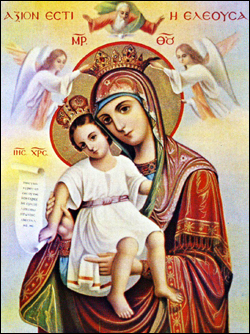|
On June 24th (the 11th by the old calendar) the Church commemorates the icon of the Mother of God “Mete it is” (“Axion esti” in Greek) or “Eleousa,” which is found on holy Mount Athos.

According to ancient tradition, in an area of the holy mountain near Kareia, there dwelled an elderly hermit with his young disciple. Rarely did they leave their monastic cell, but one evening the elder went to the Kareian cathedral to attend the all-night vigil, while his disciple remained at home. This was on June 11, 980. The youth was very pious, but did not possess any book-learning and could not sing spiritual hymns with any degree of proficiency; however, he greatly venerated the Mother of God and always sang simple but heartfelt hymns to Her. And this evening, too, remaining alone in the cell, he stood before an icon of the Heavenly Queen and sang a church song which he had memorized: “More honorable than the Cherubim and beyond compare more glorious than the Seraphim.” The youth did not add any other words, but deeply sighed, feeling great joy in his heart from the glorification of the Mother of God. Suddenly a beautiful young man appeared before the young monk. They began conversing. “What are you doing?” – asked the stranger. “Oh, I am just singing the hymn ‘More honorable’!” – the young monk answered simply. “Sing then, and I will listen to you,” – said the guest. With great spiritual tenderness the humble monk began to sing the hymn which he had learned – “More honorable than the Cherubim.”
“You do not sing properly, brother, you do not sing as we do,” – remarked the stranger. – “We glorify the Mother of God somewhat differently.” “And how is that?” – asked the surprised monk. “Thusly,” – said the guest and sang: “’Mete it is, in truth, to bless Thee, Theotokos, Ever-blessed and All-chaste, and the Mother of our God’… and only then we add the words ‘More honorable’,” – said the wondrous guest.
The young monk asked the guest to write down such a beautiful song, so that he would not forget its words, but there was no paper or ink to be found in the cell. Then the stranger marked the words on a stone tablet, which became soft as wax. After that, enjoining the youth to make sure that from then on everyone would glorify the Mother of God in such a manner, the stranger disappeared like lightning. For a long time the astonished monk stood and looked at the stone tablet with the words written on it miraculously, and then began to memorize them. When the old hermit returned to his cell at dawn, he found his disciple singing the new and wondrous hymn.
“Where did you learn to sing thus?” – asked the elder in surprise. His disciple told him of all that had happened and showed him the miraculous stone. The amazed hermit stood and looked at the stone for a long time, reading the divine words and unable to take in the miracle. “Why did you not ask the stranger who he was and what was his name?” – the elder finally said. “Forgive me, father,” – replied the disciple. – “I forgot completely. I just remember that he called himself Gabriel.” “So you did not realize which Gabriel it was, who was with you in the cell?” – added the elder, smiling, and then, standing before the icon of the Mother of God, began singing together with his disciple the new and wondrous hymn to the Theotokos. On the same day the hermit gave a detailed report of the event to the entire council of the elders of Mount Athos, and as proof presented the stone tablet with the miraculously written words. The wondrous appearance of the Archangel Gabriel to the young Athonite monk was subsequently reported to the Emperor and the Patriarch. From that time, Patriarch Nicholas II of Constant-nople decreed that the angelic song “Mete it is” should be added to the “More honorable than the Cherubim.”
The icon, called “Eleousa” (“The Merciful”), before which the new hymn was first sung, was transferred to the main cathedral and named “Mete it is” (“Axion est”).
|